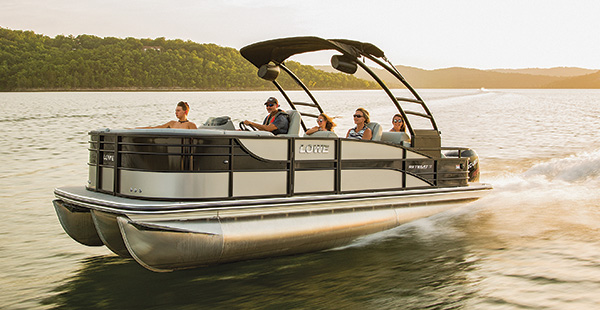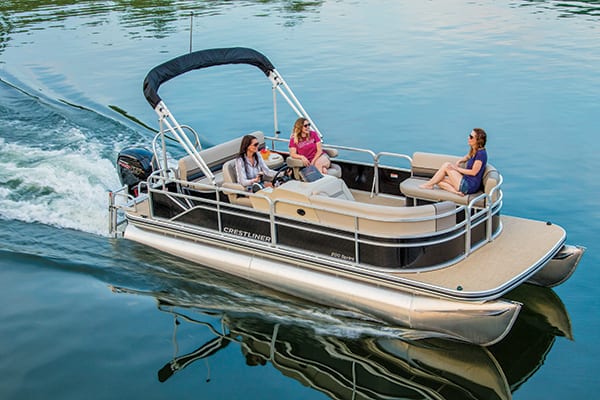
Do These 4 Things Now To Help Ensure a Summer of Safe Boating
By: Pdbmagazine.com
Boatyards, marinas and clubs are waking up after a long winter’s nap, and boaters have begun preparing their vessels for the season. While the boat needs to be looked at and readied for a summer of fun, so does your safety. The BoatUS Foundation for Boating Safety and Clean Water says that doing these four free or low-cost things now will help ensure a summer of safe boating.
1. Get a free Vessel Safety Check: Where else can you ask a professional to go over your boat to ensure it’s safe and has all the required safety equipment? And if the boat is not up to snuff, you won’t be penalized in any way and will instead get some welcome, friendly advice on how to improve. That’s what a Vessel Safety Check does, so schedule a Vessel Safety Check now. Offered by the U.S. Coast Guard Auxiliary and the U.S. Power Squadrons, Vessel Safety Checks are completely free, and you may be surprised by what they find.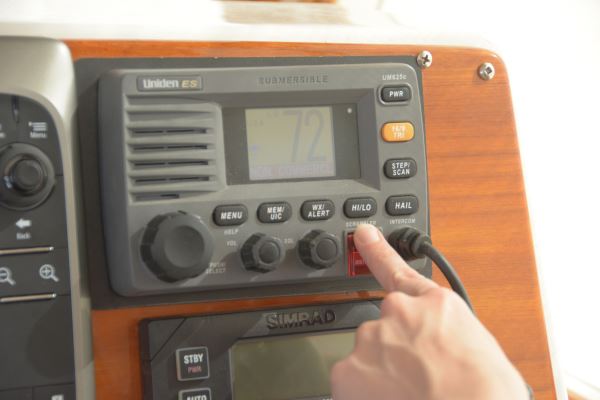
2. Register your DSC-VHF Radio to get your MMSI number: Digital Selective Calling (DSC) VHF radios can greatly reduce rescuer response times – but only if you have taken the time to register the radio and request your vessels’ unique Maritime Mobile Service Identity (MMSI) number. If it’s not registered, or still registered to the prior boat owner, you’re not helping yourself and could likely waste valuable response time in an emergency. BoatUS offers DSC VHF radio registration to the public for $25 or free to BoatUS members.
3. Inspect and prep your life jackets: Inflatable life jackets need to be opened up every season to ensure they are in good shape. Regular (noninflatable) life jackets need to be brought out of hiding, inspected, and placed in locations aboard the boat that make it very easy for passengers to access. Life jackets are no good (and not legal) if they are buried at the bottom of a storage compartment and not “readily available.”
4. Take a free boating safety course: The numbers don’t lie. The U.S. Coast Guard reports that 81 percent of boating fatalities occurred on boats where the operator did not receive boating safety instruction. Recognize the upshot of these statistics and get instruction now at BoatUS.org/Free. The free online BoatUS Foundation state boating safety course easily fits into busy schedules, allowing course takers to stop at any time and pick up again later where they left off. It could also earn your state’s boating safety certification. BoatUS membership is not required.
For all your accessories and/or vinyl flooring visit Pontoon Depot's shop site.

With Some Changes, Pontoon Boats Make a Comeback in The US!
Pic By: A pontoon boat at the Baltimore Boat Show at the Baltimore Convention Center (Kenneth K. Lam / The Baltimore Sun)
Written By: Baltimore Sun
Back this hitch up into the water, untie all the cables, and rope step onto the vinyl floor, and get yourself a coozie, Let's go….
Long before the pop-country group Little Big Town introduced its No. 1 hit, "Pontoon," pontooning has been a part of the boating community in the United States.
Its roots go back more than 60 years to a Minnesota farmer named Ambrose Weeres, who came up with the crazy idea of putting a wooden platform on two columns of welded steel barrels and spending his lazy summer afternoons fishing on a nearby lake.
But those no-frills pontoons, like Hula Hoops and Silly Putty, seemed to be a fading remnant from a simpler time.
Now, they're making a comeback with a few modern frills.
"It's exploded. Pontoons are selling much better than fiberglass boats," said Brian Schneider, whose Tradewinds Marina in Middle River has been selling pontoons for many years now.
In an industry that was struggling with a weak economy, pontoon boat sales now account for half of Schneider's income in boat sales.
Using the same Minnesota-based boat manufacturer that made the pontoon for Little Big Town's music video, as well as, for Kid Rock's video of the 2008 song "All Summer Long," Schneider said that popularity of pontoons is based largely around the fact "they're almost 100 percent usable space."
Who said anything about skiin'? Floatin' is all I wanna do, well you can climb the ladder just don't rock the boat while I barbeque…
Dan Naleppa of Salisbury is considering buying one of Schneider's pontoons after seeing them at the Baltimore Boat Show.
"It's like you're riding in your living room," Naleppa said while attending the show.
Certainly if your living room is stocked with plush couches and other accoutrements, though Naleppa said the 25-foot pontoon he is thinking about buying will not have a barbeque, minibar or some of the other amenities that seem to find their way on what many consider to be the best kind of party boats.
"They've come a long way," Naleppa said. "They're pretty roomy and they can go fast. I also like the fact that you can ride them year 'round, unlike some of the inboard-outboard motorboats I've had."
While a lot more high-tech than "The Empress" and the other boats that Weeres, who became known as "Mr. Pontoon," built en route to being inducted in Minnesota's Marina Hall of Fame, the modern pontoon industry has seen a revival in recent years. They're cheaper to make, easier to maintain, less than half the weight of comparably-sized fiberglass boats and more environmental-friendly because they typically need smaller engines.
"It seems like they're everywhere now," said Matt Finklestine, who sells pontoon boats in Lake Raystown, Pa. "Nothing is going to be a smoother ride than a pontoon boat because you don't ride on top of the water, you ride in the water. They're light, they're easier to trailer. The fiberglass chips don't break off and it makes it much easier to clean."
According to Finklestine, whose Full Performance Marine sells "everything from jet skis to 45-foot yachts," he has seen a resurgence in the past years. Finklestine said his 15-year-old company has gone from selling around two dozen aluminum pontoons in 2005 to five times that last year. The lakes around central Pennsylvania are among the most popular for pontoon boating.
"The difference between a pontoon and a regular boat is that with a pontoon, you have a lot more room. You can fit on twice as many people and you can pretty much cut the cost in half because they're very easy to make," Finklestine said at the Baltimore Convention Center, where a couple of his company's higher-end pontoons were on display and for sale during the Baltimore Boat Show.
Reach your hand down into the cooler, don't drink it if the mountains aren't blue, try to keep it steady as you recline on your black inner tube
The basic concept of the pontoon hasn't changed much since Weeres first introduced his boat, it's now a vinyl deck rather than wood attached to aluminum barrels, but pontoons have certainly been upgraded over the years to include everything like woven vinyl flooring for what essentially becomes the best under your feet feel, plus is slip resistant.
The size of the boats haven't changed (typically between 15 and 28 feet long) but they can be custom fit for whatever you need, fishing, cruising, skiing or racing.
The cost depends mostly on the size of the motor used, ranging from $15,000 to $80,000, according to industry experts. Pontoons can go as fast as 55 mph, but most are built to go a lot slower.
"The difference between a 50 horsepower and a 250 horsepower could be $20,000," said Finklestine, whose company typically sells pontoons with 90- to 115-horsepower motors. "A 28-foot fiberglass is more than $100,000, double what a pontoon costs."
Finklestine said pontoons are perfect for someone who "wants to fit a lot of people on the boat, wants some room for his kids to run around on and doesn't care about having the fastest boat on the lake."
Naleppa said he is looking forward to having his pontoon out on the Chesapeake Bay, as well as the Wicomico River and down to Ocean City this summer with family and friends, and was told that a 25-footer can comfortably seat around 10 and as many as 17, about double what can fit on a fiberglass motorboat.
Though mostly used on lakes, some pontoons have now become stable enough to operate on open bodies of water such as the Chesapeake Bay because of advanced technology. Schneider said he took "a gamble" bringing pontoons to local sailing aficionados who might be fearful that the pontoon would capsize in rougher seas.
Schneider said Premier Pontoons' development of a "PTX" center tube "lets the pontoon boats handle like a fiberglass boat." Though he doesn't recommend anything under a 20-footer on the Chesapeake Bay, "they're very stable, you've just got to get the bigger pontoons."
5 mile an hour with aluminum side wood panelin' with a water slide can't beat the heat, so let's take a ride on the pontoon makin' waves and catchin' rays up on the roof jumpin' out the back, don't act like you don't want to party in slow motion, I'm out here in the open Mmmmmmm...motorboatin' on the pontoon!
For all your accessories and/or vinyl flooring visit Pontoon Depot's shop site.

The Do-It-All Machine. Versatility Continues to Drive Popularity.
By: Boating Industry
In an industry-wide seventh consecutive year of growth, the pontoon segment continues to get more people on the water and keep them there.
Pontoons remain a key driver for the marine industry, and that’s going to continue in 2019, Statistical Surveys, Inc. (SSI) director of sales Ryan Kloppe said. “Pontoons will top 56,000 units in 2018. They just keep getting better, and have truly become a crossover boat.”
Kloppe said that SSI is anticipating around another 3 percent in growth for 2019. “It’s one of the categories that’s actually carrying the industry in year-over-year growth,” he said.
From first-time boat owners to longtime boaters switching segments, the pontoon segment refuses to be left behind.
“One of the things we’ve noticed is that the segment has been firing on so many different cylinders and is so broad based in terms of where its drawing its business from,” Info-Link director of client services Peter Houseworth said.
In terms of consumers in other segments converting to the pontoon life, Houseworth said that the segment bleeds are very balanced all-around. “We’re not seeing a single group from a single segment converting,” he added.
Houseworth said that growth within the pontoon segment has been going on for the last 20 years, however it hasn’t always been as visible because of all of the other gyrations of the market during that time period.
Hand-in-hand with pontoon popularity, the continued demand for outboard power certainly helps continue to make pontoons an appealing choice for today’s consumer.
“Pontoons are ultimately one of the key driving forces in outboard popularity,” Kloppe said. “However, it’s definitely a combination of outboard popularity driving pontoon popularity, and vice versa.”
Aside from raving popularity that began in the Great Lakes and Texas markets, the pontoon segment has been branching into new markets in increasing popularity over the last few years.
“Pontoons and their popularity are now a nationwide thing, rather than just occurring in certain places,” Houseworth said. “Florida, for example, hasn’t been a big pontoon state historically, but is now seeing big growth as a segment.”
“These boats will be around for a long time and in more and more territories,” Houseworth added.
EXPLORING NEW TERRITORY
With the popularity of pontoons continuing to rise, the industry has seen new players enter, or re-enter, the market at an accelerated rate.
After exiting the marine business in 2004, Polaris Industries Inc. busted its marine doors back open in May 2018 after signing a definitive agreement to acquire Boat Holdings, LLC, boat manufacturer of four well-recognized brands: Bennington, Godfrey, Hurricane and Rinker, in an all-cash transaction valued at a net present value of approximately $805 million.
“We started looking at Boat Holdings in early 2017,” said Scott Wine, Polaris Industries Inc. chairman and CEO during a conference call discussing the acquisition. “We’ve been looking at the marine space for four or five years. We look for great products and great brands, and they have both.”
During Q3 2018, Polaris reported that Boat Holdings was already tracking to its early expectations.
Polaris reported boat segment sales were $134 million in the 2018 third quarter, slightly better than expectations, the company stated in a news release. Reported gross profit for the boat segment was $20 million, or 15.1 percent of sales in the third quarter of 2018.
“We were pleased with the early performance of Boat Holdings, the largest manufacturer of pontoon boats in the U.S. that we welcomed to our growing powersports portfolio earlier in the quarter,” Wine said.
Although not completely new to the marine industry, following the creation of a new Marine Group and the acquisition of Alumacraft, BRP entered the pontoon segment with the acquisition of pontoon manufacturer Manitou in August 2018.
“Manitou’s strong brand, high quality pontoons and recognized technology made it a natural fit for BRP’s newly formed Marine Group,” said Tracy Crocker, President of the Marine Group. “With the acquisition of Manitou, we are strengthening our marine portfolio by entering the fastest growing segment in the boat industry.”
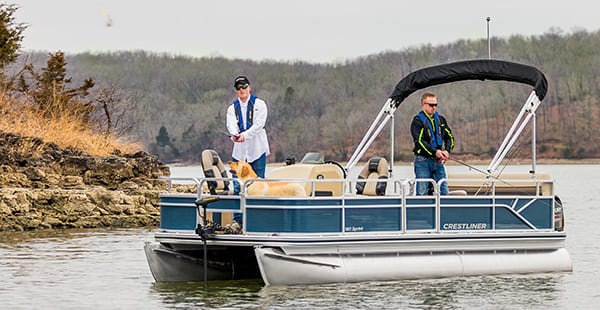
Pontoons offer versatility by providing space for the whole family and room for activities like fishing.
The segment also saw the return of the Premier pontoon brand, when the manufacturer emerged from Chapter 11 bankruptcy in March 2018.
The company announced that the reorganized Premier was to remain a Wyoming, Minnesota-based company with its current workforce in place. Premier’s exit from Chapter 11 authorized a change in ownership to a Minnesota-owned company, Premier Pontoon Holdings, LLC.
“The Premier team has worked tirelessly over the nine months to assure we continue to build high-quality pontoon boats as an industry leader,” said Rick Gallagher, Premier’s new chief executive officer.
Gallagher served as Premier Marine’s financial advisor while the company was operating in Chapter 11. The company filed for Chapter 11 on June 19, 2017. Unlike Chapter 7 and Chapter 9 bankruptcies, Chapter 11 bankruptcy gave Premier Marine a chance for a
full restructure.
Following the announcement, Premier quickly moved to establish new agreements with most of its existing vendors.
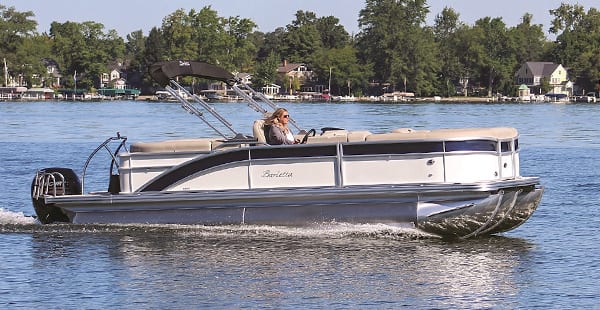
Barletta Boats offers two models: the L-Class, offered in 21, 22 and 23-foot options, and the E-Class (pictured above), offered in 20, 22 and 24-foot options.
Relatively new to the market, Barletta Boats of Bristol, Ind. made a name for itself rather quickly in the pontoon world, signing on dealerships in over 70 locations in its early stages, with no signs of slowing down.
Barletta’s 110,000-square-foot manufacturing facility roared to life in June 2017 and the company hasn’t looked back since.
Most recently, Barletta penned a partnership with Walkers Point Marina, taking the company international and into Canada. The company continues to assemble its network of dealers across the country, and is now pushing to start adding high-caliber dealers in the Canadian market.
“We’ve have a very deliberate approach to adding new dealerships to our network,” stated Jeff Haradine, Barletta’s vice president of sales. “One of our guiding principles is too ensure that if we are going to partner with a dealership, we are able to provide the resources and product necessary to form a strong, mutually beneficial partnership. The timing felt right, and the Walkers Point Marina is exactly the type of dealership we love to partner with.”
SUV OF THE WATER
Today’s consumer in the boating world is consistently looking for one boat to handle a multitude of tasks. New technologies, designs, features and more in the pontoon segment are meeting those demands of the consumer.
“A combination of better engineering, fuel efficiency, speed and all-around versatility make pontoons a kind of SUV, do-everything type of boat for consumers,” Houseworth said.
From the luxurious lines and ample space of Bennington pontoons, to the sleek and sporty Manitou designs, to the classic-look pontoons of Lowe, Misty Harbor and more, consumers are finding everything they need in a boat in today’s pontoons.
Pontoons offer the boater a large social space for entertaining, a wide array power options, fishing applications, favored accessibility, near-endless options for customization and much more.
“Pontoons especially offer older boaters — which are the primary owner in today’s market — the opportunity to take everyone out on the water, with accessibility, comfort and all-around easier boating,” Houseworth said.
Ranger Boats recently announced the coming together of the fishing and cruising pontoons worlds with the introduction of the new Ranger Reata 223FC and 220FC.
The new boats combine features for both cruising and fishing into multi-use designs to accommodate families and anglers.
“We pride ourselves on listening to our customers and dealers on their wants and needs in our product lines,” said Bart Schad, Ranger Boats vice president of sales and marketing. “We have incorporated that feedback into these new models to create an ideal fish/cruise line that exceeds the needs of everyone on board. Combined with the upgraded aesthetics throughout the entire pontoon line, we have seen tremendous response and look forward to officially bringing these new boats to market.”
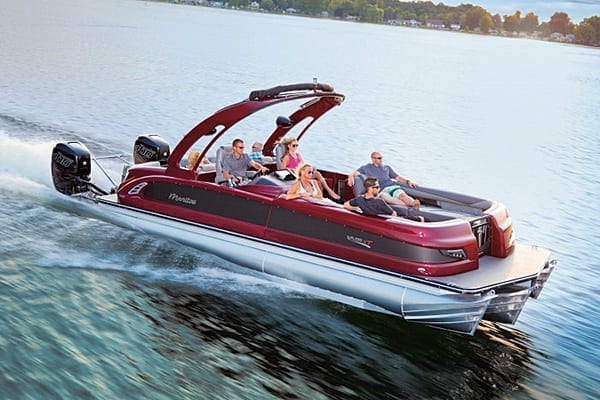
Manitou Pontoons aim to capture the sportier
consumer, by offering twin engine and wake tower options.
The new pontoons’ fish-and-play design brings together a host of creature comforts for pleasure cruising and fishing features valued by anglers.
Pontoons also offer a variety of options for the entry-level boater, with ease of use and lower price points than entry-level boats in other segments.
In March 2018, Crestliner unveiled its new Sprint Series, an entry-level pontoon for novice boaters and those looking for on-water versatility. The Sprint came nearly a year after Crestliner re-entered the pontoon market with its Rally Series.
“The Sprint fills a hole in the pontoon market,” said Crestliner President Eric Hendrickson. “There is a large contingent of boaters out there looking for an accessible pontoon they can hop into without hassle and use for a variety of on-water activities–from fishing to cruising and everything in between. Add to that an exceptional value, and the Sprint is exactly what a lot of families are looking for.”
WHEN WORLDS COLLIDE
In an effort to further push the versatility of the pontoon segment, Minnesota-based Montara Boats announced an industry-first game changer.
In early October 2018, Montara announced it developed a patent-pending design that blends the worlds of surf boats and pontoons in the industry’s first surf pontoon, including the comfort and space of a pontoon boat with the performance of an inboard surf boat.
“For the past 15 years I’ve watched neighbors and friends buy tow boats for water sports in addition to pontoons for entertaining. We’ve cracked the code on this and figured out how to blend these, creating the Surf Boss that does it all,” said Montara CEO Mark Overbye.

Montara Boats’ new Surf Boss offers an industry-first surf pontoon, equipped with a PCM inboard engine and a 5,000-pound ballast system.
Overbye is no stranger to the tow boat and tow sports world after serving as the founder and former CEO of both Moomba and Gekko. Overbye also serves as a chairman and trustee for the USA Water Ski and Wake Sports Foundation.
Montara’s new Surf Boss is available in three lengths: 21 feet, 23 feet, and 25 feet.
Equipped with PCM inboard engines, the Surf Boss features competitive surf wakes, a fully enclosed head, over 100 cubic feet of storage, dual swiveling captains chairs, jumbo-sized dual transom loungers that flip from forward to aft viewing.
Overbye told Boating Industry that PCM sent two engines to Montara Boats for use in Surf Boss prototype testing. “I’ve had a great relationship with them for 20 years,” he said. “We represent a potential entree for them into a huge market segment. The tow boat segment is roughly 10,000 units; the pontoon segment last year was roughly 52,000 units. If we have success with this, this should really open up some market floodgates.”
Features of the new pontoon include a 110-gallon fuel tank, a changing room, Zero Off GPS speed control, a 5,000-pound plus ballast system, custom tandem trailer, Rockford’s premium audio system, carrying capacity exceeding 20,000 pounds for people and gear plus a top-end speed that tops 40 miles per hour. A custom tower with dual Biminis, speakers and lights that retracts into the hull compliments the Surf Boss’s design.
“The concept of combining surfing and pontoons clearly struck a positive cord with the marine business at large,” Overbye said.
Since announcing its Surf Boss surfing pontoon in mid October, Minnesota-based Montara Boats has welcomed 27 dealers to its retail network and has more than 23 additional dealerships pending.
Overbye said that the team at Montara already has more ideas on the drawing board to further the limits of pontoons that the industry could see even four or five years down the road.
With the segment showing no signs of slowing in growth, and continued versatility and new technology coming to market, pontoons will remain a major player in the future of the industry.
For all your accessories and/or vinyl flooring visit Pontoon Depot's shop site.
- Amy Cabanas
- Tags: Boating Boating Safety Entertainment pontoon boat Pontoon Boat Operating tips

Should I Take a Pontoon Boat Offshore? Ask Sinclair Marina.
By: BoatTest.com
We have received a number of emails from BoatTEST.com members asking if it is advisable to take pontoon boats offshore or out into the Great Lakes.
Unfortunately, in their exuberance to sell boats, some boat dealers are telling customers that their boats are designed to go offshore, and we have seen one dealer’s videos that even quote a boating magazine to support this kind of usage.
Pontoons boats are designed for use in protected waters, where the sea state is such that the bow with its flat and wide deck forward will not bury itself in a wave. Simply put, pontoon boats were not designed to go offshore. However, this is not to say that there are not some times when they can venture out safely.
Pontoon Boat Caveat
Boat owners should never exceed the conditions for which a specific boat was designed. So, it is not the body of water that is so important, but rather the sea state.
On nice days, when the marine weather forecast calls for light zephyrs, pontoon boats are fine for venturing a few miles offshore on the Great Lakes or other large bodies of water. Keep in mind, conditions can change quickly. And remember, often the most difficult aspect of an offshore passage is running the inlet. Going out at slack tide may provide no difficulty, but coming in with a swift ebb or flow could be problematical and dangerous.
Low Freeboard is a Problem
In a light chop – say 1’ or so – a pontoon boat is more comfortable than any monohull for the simple reason that it has two or three narrow hulls slicing through the waves instead of one big, wide hull. But the pontoon boat’s weakness is its low freeboard and its wide foredeck. Those skinny hulls don’t have much dynamic lift or buoyancy to keep the pontoon foredeck above the waves when the wind starts blowing, in a confused sea state left over from a previous blow, or running an inlet with standing waves.


Pontoon Boats Are Vulnerable
So, if the waves are expected to be above 2’ or so high, stay in protected waters. Pontoon boats are especially vulnerable to stuffing the bow and being difficult to control running down-sea compared to a well-designed monohull with its greater freeboard forward. If a pontoon boat ships green water it can become difficult to handle, is easily susceptible to damage, and is vulnerable to capsizing despite its great initial stability. They are simply not intended for this kind of sea condition and to take one there is irresponsible.
The buoyancy of pontoon boats is limited by the size of their air chambers, which are two or three tube-shaped pontoons, and typically run from 24” to 28” in cross-section diameter. Obviously, the larger-diameter pontoon boats have more buoyancy. Tri-toons, with three longitudinal pontoons, are even more buoyant, which is why they can be used for towing sports at high speeds.
Pontoon boat owners must also realize that twin-toon platforms will rack in any kind of rough water condition. The athwartships structures between the pontoons are essentially designed to support the plywood deck, rather than to keep the pontoons in rigid position.

Captains Have Responsibilities
As with any boat, who you have onboard – and how many people – also determines seaworthiness. Fewer is better than more, physically fit are better than children or elderly. Remember, the reason to go boating is to have fun, and to keep the vessel’s passengers comfortable and safe.
While pontoon boats are very versatile, rougher seas are their biggest weakness and it’s important not to confuse the high form stability and smooth ride with rough-water capability.
For all your accessories and/or vinyl flooring visit Pontoon Depot's shop site.
- Amy Cabanas
- Tags: Boating Boating Safety How to Drive Lakes pontoon boat Pontoon Boat Operating summer tips

